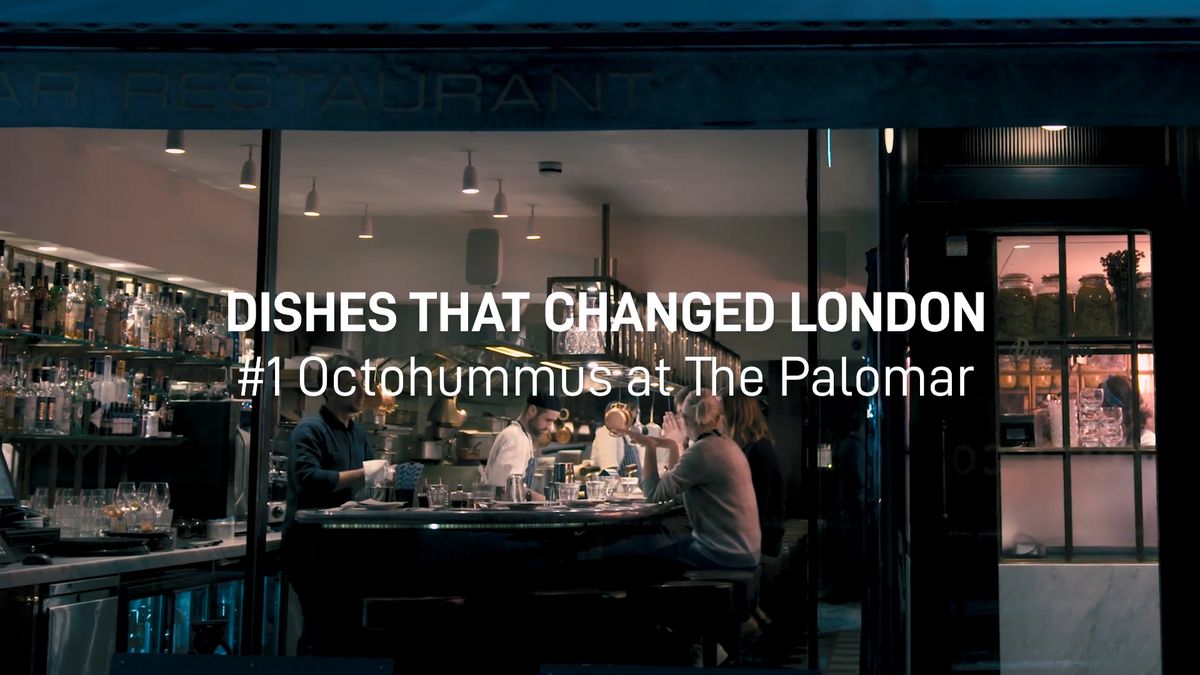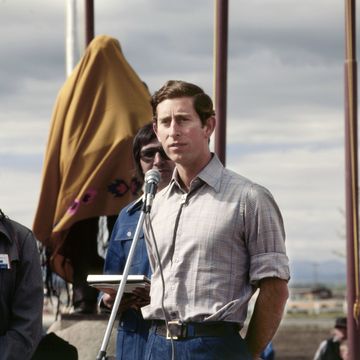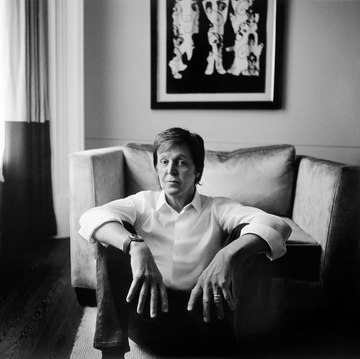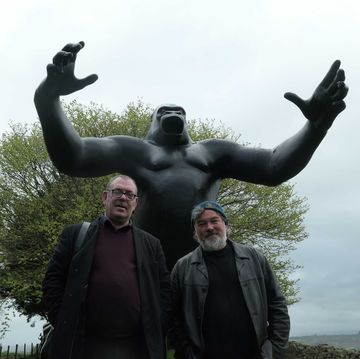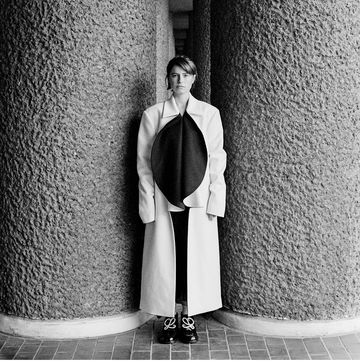"We run a breakfast menu from 8am to 10:30am, then until noon it's coffee and cake of the day, noon to 2:30pm is a lunch menu, then after that we do pies or hot sandwiches until 6pm, and an à la carte dinner menu until 10pm."
Opened in 2014, The Coach is chef-patron Tom Kerridge's second pub in the pretty, riverside town of Marlow, Buckinghamshire. His other, The Hand and Flowers, is famous for being the first British pub to receive two Michelin stars. Not only did the accolades heavily lengthen the waiting list for Saturday night tables (over a year at one point), but they also confirmed that the humble British pub, the boozer, the local, was now a place where you could eat seriously good food. The gastropub movement had reached its delicious, and not inexpensive, apogee.
On first inspection, The Coach looks like you expect a pub to look — bare stone walls, exposed beams, wine glasses dangling upside down above those elongated beer pumps rising out of the bar. Look closer, though, and you see the crisp white linen napkins and carefully arranged cutlery, the open kitchen full of slickly barbered young chefs and the individual club sandwiches carefully arranged under a glass cloche on the bar. The Coach aims to be all things to all punters: beer, cider, chips, nuts, crispy pig's head, rotisserie quail, Gloucestershire kippers with parsley beurre noisette.
"If we're going to pay rent on a place 365 days a year, then let's be open and try to maximise it," Kerridge says. "If you've got 20 minutes you can pop in for a portion of chips, and if you've got two hours you can order what you like. And you can't book. It's our vision of what a pub should be. Pub 2.0."
Gastropubs emerged in the early Nineties because a few shrewd foodies were sick of the stuffy rigmarole and expense often accompanying dining in a restaurant — reservations, waiting lists, wine lists, starters, oily maître d's and the like. Why did eating out demand such fussy formality? Why couldn't you eat your osso buco at the bar with a pint of bitter? Following the lead of such trailblazers as The Eagle in Farringdon, London (commonly regarded as the first gastro), countless pubs swapped their sticky laminated menus of limp sandwiches for chalkboards offering moules-frites and gourmet rarebit, changing British hospitality forever. Now, nearly three decades later, many food outlets make informality paramount — no reservations, small sharing plates etc — and it's a safe bet your local pub will consider its kitchen order before it thinks about what beers to have on tap.
The gastropub revolution came at the right time, because the pub industry was in a pretty dismal state. Much has been written recently about its steep decline — last year the British Pub Association stated that as many as 29 were closing every week — but in truth, the numbers have been dwindling for a long time. At the start of the 20th century, there were more than 100,000 pubs in the UK, but in 2014 there were just over 50,000. That's a closure rate of more than one a day.
Today, various polemics have decried the more recent nails in the coffin, including the smoking ban, cheap supermarket booze, Sky Sports and, of course, the property developers. They've shouldered the brunt of the blame latterly thanks to several particularly outlandish stories of architectural injustice, such as the Carlton Tavern in Maida Vale, west London, which was demolished without permission in spring 2015 while Historic England pondered listing the building.
Gastros may have been good for us, good for the British restaurant industry and good for thirsty parents with hungry young children, but they weren't good for pubs.
As gastros' stock rose, that of the alternative plummeted. Everyone wanted hand-cut steak sandwiches and Rioja, so the street corner boozers — those appointed with pool tables, dartboards and TVs, still clinging on to the idea the pub was an extension of the sitting room, a cornerstone of the community — were left to rely on the custom of the loyal, the elderly and the borderline alcoholic. But even the latter were starting to die out.
"Lunchtime drinking doesn't exist anymore," says career landlady Farika Holden, who has run pubs in London for 20 years. "That was my bread and butter, what paid the rent. Then anything you made in the evening was your profit. You worked your ass off between noon and two and then that was it. My first pub was near ITN and Thomson Reuters in Holborn so there was lots of media nearby. In the late Nineties, girls would drink three bottles of wine between two and go back to work! It doesn't happen any more, it's just not cool."
Holden decries the loss of various traditional pub fixtures. She misses the carpets ("the acoustics are terrible without it"), the smokers ("I don't think [the ban] was good for the industry — if you want to have fun then you'll hang out in the smoking area, where the fun people are") and a time before free Wi-Fi ("we didn't have internet at my last pub — if I saw people on their phones I'd scream at them. There's no way I'd do that now, though").
Holden is right, of course, that in any revolution there are losses as well as gains. It is easy to feel nostalgia for the pubs in which most of us had our first pints — cheap, fizzy continental lager, most likely — forged lasting friendships, tried to cop off with girls and became addicted to tobacco. It is also easy to forget most of those pubs were, in fact, pretty awful: smoky, sticky-floored, noisy, ugly, occasionally violent, unwelcoming to women and patronised by slightly sad, blue-nosed men who couldn't face going home, because the reality that held was even more disappointing.
It's equally easy, though, to feel deflated by the prospect of another night in an overpriced gastropub, surrounded by Sancerre drinkers discussing house prices, and where dinner for two can cost £100. And you have to reserve a table in advance, which is so not the point of a pub. But dry those tears and order another drink, because there is a third option. The British pub is not dead yet.
It's just before 8pm on a Wednesday night in Kentish Town, north London, and I'm sitting on a stool at the hefty wooden bar of The Southampton Arms on Highgate Road. From the street, the pub doesn't look particularly remarkable. The frontage, painted in a thick blue-black gloss, is small and unassuming and sandwiched between an estate agent's office and a slightly tired looking townhouse. It's cold, so there's no one outside, and the heat within has steamed up the sole big square window. You'd be forgiven for walking past without giving it a second glance. Within, however, an open fire has heated up the narrow space, and the room is stuffed with jovial drinkers.
To my right, a fellow twenty-something guy sips a pint of Pacific Cascade and scrolls through Instagram, switches over to BBC News, then his email, then back to Instagram. Like every member of his generation, he needs constant stimulation to stave off the dreaded possibility of being alone with his thoughts. To my right, a man in his seventies nurses a pint of inky black stout and stares at the white ceramic tiles on the wall behind the bar. He's fine with his own thoughts; the last thing he wants is any kind of stimulation.
I order a pint of American pale ale (one of 18 tap beers and ciders) and a sausage roll. The barman walks over to the glass-fronted heating tray at the end of the bar and plucks one out from between a crackling-topped joint of pork and a pile of pork pie quarters. It lands in front of me halved, on a small plate and accompanied by a blob of English mustard.
Away from the bar the different-sized tables are occupied by people of all ages, both genders and seemingly, many walks of life. Everyone looks happy, and all are drinking foamy beer or cloudy cider from glass pint jugs. There's no feeling of exclusivity, no sense we're here because it's cool, nothing pop-up about it in the slightest. Over in the far corner, an old boy is quietly warming up on the clarinet. He's soon joined by another who sits at a small, battered piano, and they launch into some jazz tune I don't know, but probably should. It's unnervingly ebullient, borderline utopian.
"When we opened in 2009," remembers Southampton Arms owner Peter Holt, "there were two kinds of pub — the working man's boozer and the gastropub for your 4x4 drivers. We hated that people were separated like that, and we wanted to open somewhere everyone could go to."
That's exactly what Holt and his team have done. The focus is on drink, rather than food. Sure, the website states the Southampton Arms has "18 handpulls of lovely ale and cider and a fridge full of lovely meat", but the small selection of pies and sandwiches are but a compliment to the booze, mere fodder to keep the belly full while you're drinking.
In the Eighties and Nineties, pubs lost trade to the wave of wine bars. They attracted the young and the affluent, and more importantly, women. Chains like All Bar One and The Slug and Lettuce (the first opened in Islington in 1984) took existing (often struggling) pubs and revamped them — stripping out the moribund carpets, wooden furniture and brass fittings, and installing floor-to-ceiling windows that filled the space with light and let people (women, really) see what was going on inside. But a funny name does not a boozer make, and the gastropubs of the Nineties and Noughties made the chains seem unsophisticated, less sexy. The thing is, gastropubs aren't really pubs: they're restaurants with bars.
At The Southampton Arms, Holt and team have kept many of the traditional pub elements — creaky wooden floors, mismatched furniture, leather-topped stools. The walls are covered in little Victorian artworks and there are even a few mirrors with brewery logos on the glass — but somehow, it doesn't feel staid, fogeyish, contrived or anachronistic. It feels like everything is as it should be.
Another culprit in the death of the great British pub is management. Thousands of UK pubs are owned by a brewery, or more often, a "PubCo" such as Enterprise Inns (about 5,350 pubs) or Punch Taverns (about 3,588). The tenants receive lowered rates of rent on the lease, but must buy their beer from the PubCo or brewery at a considerably higher price than in the open, freehouse market, a 400-year-old model known as the "beer tie". The landlords aren't especially well protected either, as Farika Holden explains. "It costs you nothing to get in, maybe 20 or 30 grand, first and last month's rent, beer deposit, chairs, glasses — whatever they've got. You can leave in three months [notice] and be kicked out in three months [notice]."
There are two schools of thought on PubCo management. Some maintain the pubs they buy and refurbish would have been lost without their intervention, while others suggest each is made in the bland image of the last, giving a series of homogenised pub-themed bars. Peter Holt falls into the latter category: "For years, they've owned about half the pubs in the country and forced us to drink mass-produced rubbish they brew in huge volumes and sell on to pubs at huge profits."
Holt and his team are proudly independent. On the Southampton's website is an open letter to The Jolly Butchers, a pub not too far away that Holt suggests has copied his "Ale & Cider House" signage. It starts: "We don't like big brands, we hate chain pubs and we're sick to death of chain shops and the fact that nearly every British town centre looks exactly the same as the next. What we need is more individuality, more creativity and more variety. The last thing The Southampton Arms wants is to be part of a brand or chain, be it real or perceived."
The letter goes on to wish The Jolly Butchers well and states that it's a great pub, but it also mocks their lack of imagination, and highlights their gastro sensibilities. Clearly, Holt doesn't want the Southampton to be mistaken for something it isn't, not even a cool (and popular) gastropub in Stoke Newington.
Holt also owns The Cock Tavern in Hackney, east London. Traditionally one of London's poorest areas, it's seen massive gentrification since the Eighties and is now teeming with vintage clothing stores, organic grocers and concept bistros. There's even a vinyl-cum-coffee-shop-cum-poetry-slam-venue on Lower Clapton Road, once known as "Murder Mile". The crowd at the Cock is noticeably more trendy and self-conscious than at the Southampton ("we have architects and doctors, students and window cleaners all come and enjoy the pub together," Holt claims), but that's Hackney in general. The ethos is the same, though: beer and cider before bread and wine. As its Twitter page states: "Shitloads of UK indy beer and no silly nonsense". They've taken it a step further at the Cock and set up a cellar brewery. There aren't many bigger, foamier fuck-yous to the PubCo model than that.
Holt's pubs are not alone: The Kings Arms, Bethnal Green, tweets photos of its #beeroftheday and discusses little else; The Queen's Head, King's Cross, is a narrow place not unlike the Southampton; The Apple — a boat moored up on the quayside in Bristol — has some 40 ciders on tap. They all serve plates of charcuterie and cheese, but you get the sense they'd scrap the food if we didn't all insist on eating something when we drink.
Then there's the micropub, a different beast but with similar ethics. These are tiny, community-run places in former Post Offices, stables and corner shops devoid of TVs, jukeboxes, pool tables and anything else that might detract from conversation, good local beers or conversation about good local beers. The first, The Butcher's Arms, opened in Herne, Kent in 2005, and more followed nearby soon after, but Camra (the Campaign for Real Ale) suggests there might now be more than 200 across the country.
It looks like this new resistance of proper pubs is going to expand in the coming years. MPs recently pushed through legislation to allow some pub tenants to opt out of the beer tie when they next renew their lease, giving them the option to stock any beer they want. "I think the PubCos are losing their grip on the tie, which is fantastic," says Holt. "At long last you'll be able to walk into any pub in the country and have some decent beer to choose from."
Clearly, Holt and his contemporaries are concerned most with what's in the taps and so they should be; with the rise in craft brewing there's an unbelievable amount of good beer made in the UK. But my evening at the Southampton wasn't startling simply because of the contents of my glass. Even though I was on my own, I felt at ease, included and part of something wholesome. Like observing a pastoral painting from within. (On reflection, I ended up having three pints of six per cent beer, so my giddiness may not have been purely contextual).
There was a time when the pub was a place you went to get a bit merry, see your mates, make small talk with pretty girls and eat something stodgy, unctuous and delightfully bad for your health. Somewhere along the way we lost interest, but now, pub by pub, we're getting it back.
I asked Tom Kerridge for some advice: if I were to open my own pub, where should I put it and how should it be run?
"Open it where there's people around to come to it all day long, a city centre is perfect, where there's high street trade," he says. "Look at Wetherspoons, you might not like the product, but stand back and look at what they offer from breakfast right through to dinner. It's brilliant."
It's impossible to argue with Kerridge's success. But we've got enough Wetherspoons, perhaps it's time for something different.


